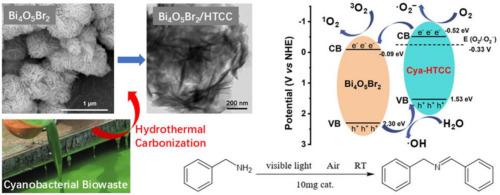生物废弃物源HTCC修饰Bi4O5Br2纳米花增强苄胺光催化氧化偶联
IF 5.4
3区 化学
Q1 CHEMISTRY, INORGANIC & NUCLEAR
引用次数: 0
摘要
光催化氧化偶联是一种经济高效、环境友好的合成亚胺的方法。然而,传统光催化材料的可见光利用效率低、稳定性差、反应条件苛刻,限制了其应用。本文以N,N-二甲基甲酰胺为溶剂,在不使用表面活性剂的情况下制备了Bi4O5Br2纳米花。然后对蓝藻华产生的废生物质进行水热处理,得到水热碳化碳(Cya-HTCC),并用于Bi4O5Br2的改性。所制得的复合光催化剂对胺具有优异的光催化氧化偶联性能。表征结果表明,Cya-HTCC与Bi4O5Br2之间存在明显的相互作用,形成异质结构,提高了光生载流子的分离效率。实验结果表明,在最佳配比下,以空气中的氧气为氧化剂,在可见光照射下,Bi4O5Br2/HTCC(5)在4 h内对苄胺的转化率为97.52%,主要产物n -苄基苄基苄胺的选择性达到97.94%。转化率分别是纯Bi4O5Br2和Cya-HTCC的2.1倍和1.5倍。本研究为苄胺的经济、可持续、绿色转化提供了新的思路。本文章由计算机程序翻译,如有差异,请以英文原文为准。

Modification of Bi4O5Br2 nanoflowers with biowaste-derived HTCC for enhanced photocatalytic oxidative coupling of benzylamines
The photocatalytic oxidative coupling of amines is an economically efficient and environmentally friendly method for imine synthesis. However, the application of traditional photocatalytic materials is limited by their low visible-light utilization efficiency, poor stability, and harsh reaction conditions. Herein, Bi4O5Br2 nanoflowers were prepared using N,N-dimethylformamide as the solvent without the use of surfactants. Waste biomass derived from cyanobacterial blooms was then subjected to hydrothermal treatment to obtain hydrothermal carbonization carbon (Cya-HTCC) and used for the modification of Bi4O5Br2. The resulting composite photocatalyst exhibits excellent photocatalytic oxidative coupling performance for amines. Results of characterization shows that there is a significant interaction between Cya-HTCC and Bi4O5Br2, forming a heterostructure, which improves the separation efficiency of photogenerated carriers. Experimental results indicate that under the optimal ratio, Bi4O5Br2/HTCC(5) achieves a conversion rate of 97.52 % for benzylamine within 4 h under visible-light irradiation using oxygen in the air as the oxidant, with the selectivity of the main product N-benzylidenebenzylamine reaching 97.94 %. The conversion rate is 2.1 times and 1.5 times those of bare Bi4O5Br2 and Cya-HTCC, respectively. This work provides a new idea for the economical, sustainable, and green conversion of benzylamine.
求助全文
通过发布文献求助,成功后即可免费获取论文全文。
去求助
来源期刊

Inorganic Chemistry Communications
化学-无机化学与核化学
CiteScore
5.50
自引率
7.90%
发文量
1013
审稿时长
53 days
期刊介绍:
Launched in January 1998, Inorganic Chemistry Communications is an international journal dedicated to the rapid publication of short communications in the major areas of inorganic, organometallic and supramolecular chemistry. Topics include synthetic and reaction chemistry, kinetics and mechanisms of reactions, bioinorganic chemistry, photochemistry and the use of metal and organometallic compounds in stoichiometric and catalytic synthesis or organic compounds.
 求助内容:
求助内容: 应助结果提醒方式:
应助结果提醒方式:


